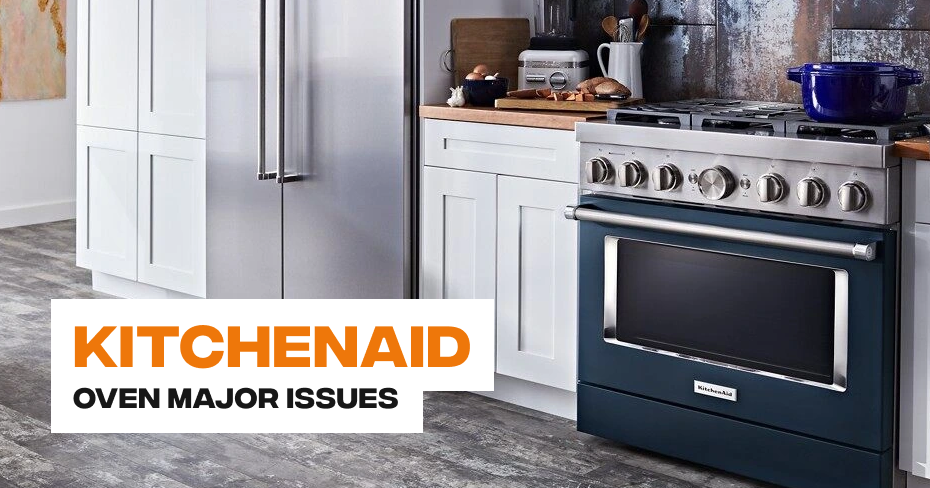
Kitchenaid Oven Not Heating
You may not use your oven daily, but challenge yourself to go a week without it. We depend on our ovens more than we realize! So when you’re faced with the common issue of it not heating accurately – or at all – it can be a blistering inconvenience. Why is your KitchenAid oven not heating properly? While it could be a faulty sensor or a busted igniter, it can also be a quick DIY fix like a thermostat recalibration.
KitchenAid Oven Not Heating Up? This Could Be Why.
Whether your KitchenAid oven isn’t heating up at all or if it’s simply not climbing to the appropriate temperature, it’s a pesky mess that’ll keep bugging you until it’s resolved. We’ll discover possible sources along with helpful tips straight from the pros. With our troubleshooting guide, you’ll have frozen pizza nights back in no time.
Calibrate KitchenAid Oven Thermostat
While your oven’s control panel reflects the set temperature, the temperature inside the oven can change. The thermostat mediates these changes and signals the oven to raise and lower the heat in order to maintain the set temperature. To remedy your KitchenAid oven not heating up, make sure the temperature reading and the actual temperature are in sync by recalibrating the thermostat.
Conduct this biscuit test prior to calibrating your oven temperature:
- With your can of biscuits handy, fully pre-heat your oven to the instructed temperature.
- Place biscuits evenly 1 to 2 inches apart on an ungreased cookie sheet, allowing a 2″ space between the sheet and the oven’s walls on all sides.
- Position the rack in the middle of your oven.
- Put the tray of biscuits in the oven for the time specified on the biscuit package.
- Remove biscuits from the oven.
If the biscuits turn out to be evenly browned, your oven is calibrated correctly. If the biscuits aren’t evenly browned, then your oven temperature might require calibration. For information on how to calibrate KitchenAid oven temperature for your specific unit, refer to the owner’s manual.
Oven Temperature Sensor Is Faulty
The oven sensor and the thermostat are a compatible duo that works together to ensure premium baking results. By using an electrical current, the temperature sensor creates resistance to hikes in temperature. However, like many famous duos, one can pass its prime and cause the pair to perform inadequately. These sensor issues can make your KitchenAid oven temperature not accurate.
- Thermostat and temperature sensor demand recalibration
- The temperature sensor is touching the oven’s interior wall, resulting in inaccurate oven temperature
- Sensor is defective
Though a faulty sensor requires professional replacement, recalibrating and readjusting the sensor is something you can do to rectify the issue.
Oven Bake Element Has Failed
Electric ovens heat up food when the coils at the oven’s base receive adequate heat from the electrical current. A properly functioning coil will display a red glow from positive continuity during the oven’s operation. If your oven is saddled with a defective heating element, it may illustrate signs of visible damage, such as blisters or cracks.
The coils will also produce a fragmented red glow as opposed to a uniform one if experiencing a broken heating element, or they may not glow at all. Conduct a multimeter test to examine the coil’s continuity. If the multimeter exhibits negative continuity, the bake element needs immediate replacement.
Oven Igniter Is Broken
In regards to gas ovens, when the igniter receives an electrical current through the gas valve, the valve opens to permit gas flow. If your oven isn’t heating up, it’s possible a malfunctioning igniter is preventing the gas valve from opening. When this happens, you’ll notice your oven isn’t accurate as the internal temperature becomes too low before the gas reignites. Cut off the gas to the oven and try to turn it back on. If the igniter’s spark stutters or doesn’t spark at all, the igniter is broken and needs to be switched out.
Convection Fan Motor Is Defective
If your KitchenAid oven not heating is a convection model, a defective fan motor is a likely culprit. Convection ovens produce faster and more balanced cooking by way of a fan motor that circulates the oven’s hot air. If the motor breaks down, the fan isn’t able to circulate, laying the ground for insufficient cooking times.
Attempt to test the fan motor with a multimeter to show continuity. The motor is potentially defective if the test reveals a lack of continuity. Check if you’re able to effortlessly able to turn the fan blades by hand. If you experience struggle, you have a weak or broken motor. Either instance requires replacement.
FAQ: Why Is My Kitchenaid Oven Not Heating Up?
While the most common causes of an oven not heating up include a faulty igniter or a broken heating element, several other components can cause this problem.
They include:
- A malfunctioning bake or broil spark electrode – Inspect the electrodes for any physical damage or debris and make sure they are properly connected to the oven’s electrical circuit.
- A problem with the safety valve – Check the safety valve, usually near the gas supply line, for any hissing sound when the oven is turned on. Some models also have a valve testing button that, when pressed, will check the valve’s proper functioning.
- Damage to wires – Inspect the wires for any physical damage or loose connections while taking proper safety precautions and ensuring they are properly connected.
- Faulty oven control board – If the oven is not heating and the control board is suspected, a professional oven repair technician should be consulted for proper diagnosis and repair or replacement of the control board.
